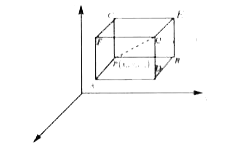(P)-1 412. A parallelopiped is formed by planes drawn through the points (1, 2, 3) and (9, 8, 5) parallel to thecoordinate planes then which of the following is not the length of an edge of this rectangularparallelopiped(A) 2(B) 4(C) 6(D) 8
Step by step video & image solution for (P)-1 412. A parallelopiped is formed by planes drawn through the points (1, 2, 3) and (9, 8, 5) parallel to thecoordinate planes then which of the following is not the length of an edge of this rectangularparallelopiped(A) 2(B) 4(C) 6(D) 8 by Maths experts to help you in doubts & scoring excellent marks in Class 12 exams.
Similar Questions
Planes are drawn parallel to the coordinate planes through the points P (x1,y1,z1)andQ(x2,y2,z2) find the length of the edges of the parallopiped.
 02:24View Solution
02:24View SolutionPlanes are drawn parallel to the coordinate planes through the points (1,2,3)and(3,−4,−5). Find th lengths of the edges of the parallelopiped so formed.
03:14View SolutionA parallelopied is formed by planes drawn through the points (2,4,5)and(5,9,7) parallel to the coordinate planes. The length of the diagonal of parallelopiped is
02:47View SolutionIf a parallelopiped is formed by planes drawn through the points (5, 8, 10) and (3, 6, 8) parallel to the coordinate planes, then the length of diagonal of the parallelopiped is
02:03View SolutionIf a parallelopiped is formed by planes drawn
through the points (2, 5, 3) and (6, 7, 9) parallel to
the coordinate planes, then the length of its
diagonal is02:01View SolutionA parallelopiped is formed by planes drawn through the points (1, 2, 3) and
(6, 8, 18) parallel to the coordinate planes then which of the following is not
the length of an edge of the rectangular
parallelpiped02:07View SolutionA rectangular parallelopiped is formed by planes drawn through the points (5,7,9) and (2,3,7) parallel to the coordinate planes. The length of an edge of this rectangular parallelopiped is
01:51View SolutionPlanes are drawn parallel to the coordinate planes through the points (1,2,3)and(3,−4,−5). Find th lengths of the edges of the parallelopiped so formed.
04:01View Solution

